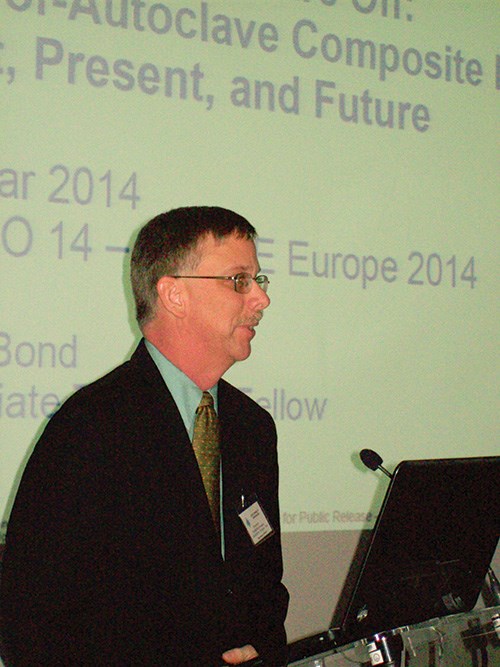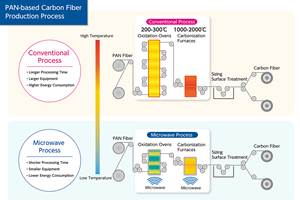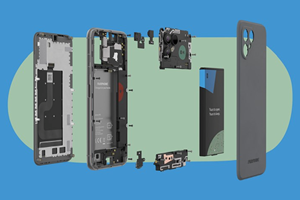SAMPE Europe 2014 Review
SAMPE Europe’s 35th International Conference (SEICO 14) was also its last. Beginning in 2015, SAMPE Europe will henceforth organize one large annual conference, combining its SEICO and SETEC events into a multitrack multidisciplinary conference and exhibition.
The 35th SAMPE Europe International Conference (SEICO 14) was unusual it two significant respects; First, its usual keynote address focused on the aerospace industry was followed by a second keynote message and a strong set of papers that were the outgrowth of increasing interest in and use of advanced composites in the automotive industry. Second, SAMPE Europe’s board of directors, at its spring meeting, re-envisioned the strategic direction of SAMPE Europe conference programming. The result? Beginning in 2015, SAMPE Europe will organize one large European conference, combining its spring SEICO and fall SETEC events.
The SAMPE France chapter will host the first one, which will take place in Amiens, France, a one-hour train ride from Charles De Gaulle airport. The combined conference, which will bear an as yet undetermined new name and branding, will travel to major European industrial centers. The new multitrack multidisciplinary event will include an exhibition.
In the spring of 2015, however, SAMPE Europe will put in place, alongside the JEC Paris exhibition, a one or one-and-a-half day executive advanced materials summit. This summit will feature presenters by invitation only, who will address key issues affecting the composites and advanced materials community in Europe, on the day prior to the opening of the JEC show.
Aerospace: Coming out of the autoclave
SEICO 14’s aerospace keynoter, Gary G. Bond, from the Chicago, Ill.-based Boeing Co.’s operations in St. Louis, Mo., spoke engagingly about “Taking the Pressure Off: Out-of-Autoclave Composite Prepreg, Past and Future.” He began by telling attendees that when Boeing appointed him its new manager of disruptive technology seven years ago, the goal without doubt was to get out of the autoclave (OOA), but the question was which method of OOA? Beyond the obvious savings in capital equipment and and energy consumption, OOA would remove limits on part size. Boeing preferred familiar thermoset prepreg for its consistency and its potential for automation, also a goal. “This was not Boeing’s first time at the rodeo,” Bond quipped, noting that Boeing, also preferred not to hurry into new development, began with a tooling prepreg and then used it for part prototypes because OOA processing would save time and money to get a prototype in the air, despite porosity and other problems. Although engineers hoped a second-generation OOA prepreg, LTM 45, could be used for finished parts, its 10-day out-life was too tight. A third-gen toughened product, CYCOM 5320-1, however, can produce less than one percent void content, has a 30-day out-time and is performance- and weight-competitive with autoclaved prepreg.
Bond credited the Defense Advanced Research Projects Agency (DARPA) for creating a disruptive-technology funding program and partnering with Boeing “in a very real way,” he recalled. “We are in a period here when the U.S. government is willing to put money toward projects like that,” he added, noting that DARPA, the Air Force Research Lab (AFRL) and Boeing “worked very closely together to make this vision come out for OOA.“ Further, all agreed to the metrics that determined success and that the results should be, as much as possible, in the public domain. He told attendees, “We tried to make it as much yours as ours.”
Bond reviewed the program’s history, noting that the goal was to “go ugly early” and try difficult configurations to discover the material/process “Achilles’ heels and address them.” Successes eventually culminated in a recent demonstration of the material in an oven-cured 68-ft wingskins for the Phantom Eye UAV. What’s ahead? Bond says the goals include even larger and thicker structures, more robust processing, tougher resins that will allow ATL/AFP machines to operate at speed (but available at lower cost). “You have to have a material that is harmonized with the process before you can get those laydown rates,” he commented. Further, bagging and cure time must be shorter and the prepreg and process must produce both high modulus and high strength in the part. Finally, 30-day out-time is good, he agreed, but it won’t be enough for the large structures to come.
During a Q&A period, Bond commented in answer to a final question about goals that Boeing wants a “robust resin system that is much more forgiving.” So much so that, “the worst tech, on his worst day, could make an acceptable part.”
Automotive: A thermoplastic composite future?
SEICO 14’s second keynote, titled “Next Challenge in CFRTP for Mass Production Automobile Application,” Dr Jun Takahashi of the University of Tokyo observed that Japan makes 30 percent of the world’s automobiles and 50 percent of its carbon fiber. For that reason, a Japanese National Project is addressing carbon fiber availability and price and the speed of automotive carbon fiber part production. Takahashi says the project has 34 partners, has already spawned three composites research centers and will benefit from government funding — the equivalent in yen of roughly €15 million each year throughout the program’s duration. The hope is to reduce car weight by 30 percent.
The program timeline assumes that 2020 is starting point of mass production of carbon fiber parts, and that, by 2030, fiber demand for auto production will reach 1 million metric tonnes (2.2 billion lb).
Notably, the program’s current matrix of choice is not a thermoset, but a thermoplastic — specifically, a maleic acid-modified polypropylene (PP). Takahashi argued that carbon fiber/PP doesn’t shatter and break on the tensile side like carbon/epoxy, the resulting parts can be welded rather than adhesively joined (welding is more familiar to auto OEMs), and that thermoplastics better accommodate nut inserts for assembly. Further PP is compatible with program goals that include relatively low mold temperatures and longer mold life.
That said, Takahashi clearly identified the challenge ahead: “CFRTP is not yet a mature technology.” Anticipated outcomes depend on the conjunction of positive factors that include reductions in the cost of fiber production, sufficient supply to meet increased demand, design for manufacturing, and a major reduction in the cycle time for CFRP auto parts. Although part cost is directly related to mold cycle time, Takahashi emphasized that the brunt of the program’s thrust is fiber cost and that recycled carbon fiber holds the most promise for controlling part cost. His research data demonstrate that the use of recycled fiber will simultaneously reduce waste and reduce the material cost of CFRP parts to a level that, he contends, will be competitive in 2020 with aluminum.
The assumption is that carbon fiber recycling will mature and supply sufficient recycled fiber to meet demand. He noted that research indicates no depreciation of fiber properties during recycling and, further, there is also no appreciable drop in finished part performance between those reinforced with continuous virgin fiber and those made with long but discontinuous fiber derived from recycling efforts. He pointed out that fiber length, in fact, isn’t a critical issue: Recycled fibers of any length, he contended, will find a place in auto production.
In response to a query during the Q&A session that followed, Takahashi revealed that the recycling method in the program’s sights does not involve burning away resin. Instead, the “green” process involves high-temperature water vapor and does no fiber damage. Resin removal is “almost 100 percent.”
When a representative from an auto OEM noted that the program is focused on reducing the cost of processing CFRP and asked if the there would also be an effort to reduce the cost of the raw fiber, Takahashi, at first, dodged the question. But after a bit of prodding, he admitted that he couldn’t be definitive, but said with a smile, “Don’t worry. We have a plan.”
For additional information about SAMPE Europe’s new event schedule, please contact Dr. Gino Torre at luigi.torre@unipg.it.
Related Content
Bio-based acrylonitrile for carbon fiber manufacture
The quest for a sustainable source of acrylonitrile for carbon fiber manufacture has made the leap from the lab to the market.
Read MoreJEC World 2023 highlights: Recyclable resins, renewable energy solutions, award-winning automotive
CW technical editor Hannah Mason recaps some of the technology on display at JEC World, including natural, bio-based or recyclable materials solutions, innovative automotive and renewable energy components and more.
Read MoreMicrowave heating for more sustainable carbon fiber
Skeptics say it won’t work — Osaka-based Microwave Chemical Co. says it already has — and continues to advance its simulation-based technology to slash energy use and emissions in manufacturing.
Read MoreComposites end markets: Electronics (2024)
Increasingly, prototype and production-ready smart devices featuring thermoplastic composite cases and other components provide lightweight, optimized sustainable alternatives to metal.
Read MoreRead Next
Plant tour: Daher Shap’in TechCenter and composites production plant, Saint-Aignan-de-Grandlieu, France
Co-located R&D and production advance OOA thermosets, thermoplastics, welding, recycling and digital technologies for faster processing and certification of lighter, more sustainable composites.
Read More“Structured air” TPS safeguards composite structures
Powered by an 85% air/15% pure polyimide aerogel, Blueshift’s novel material system protects structures during transient thermal events from -200°C to beyond 2400°C for rockets, battery boxes and more.
Read MoreAll-recycled, needle-punched nonwoven CFRP slashes carbon footprint of Formula 2 seat
Dallara and Tenowo collaborate to produce a race-ready Formula 2 seat using recycled carbon fiber, reducing CO2 emissions by 97.5% compared to virgin materials.
Read More
























